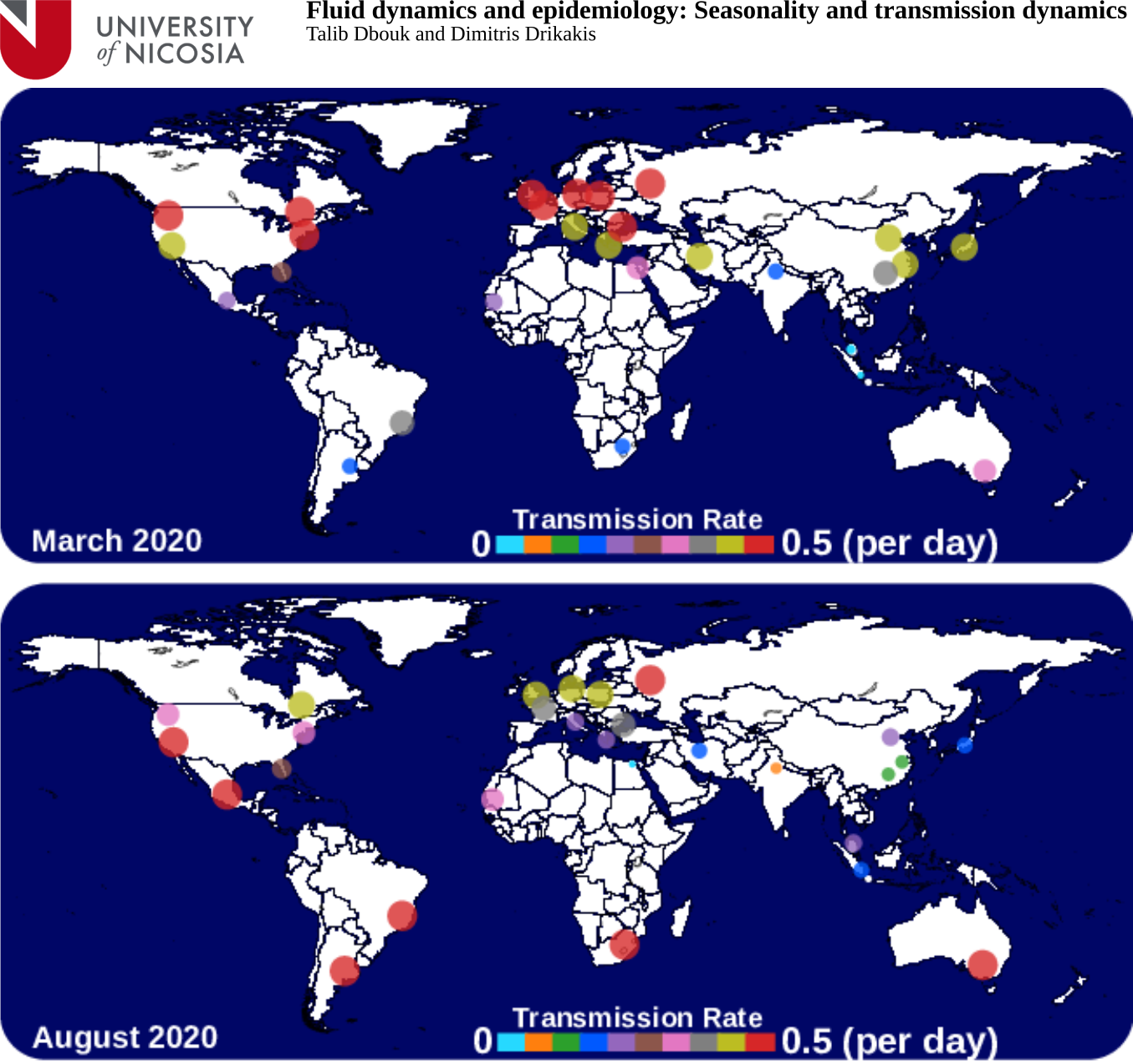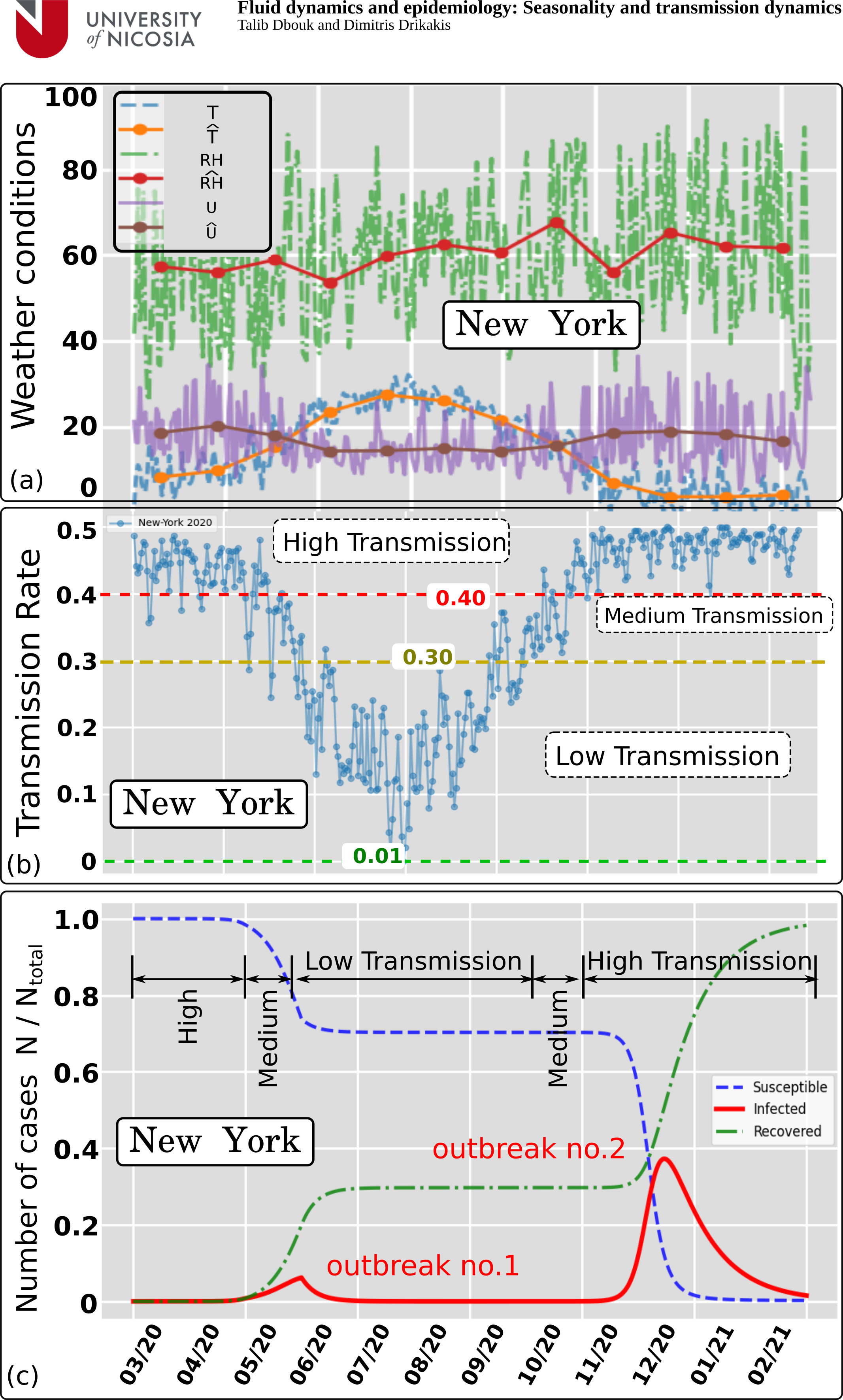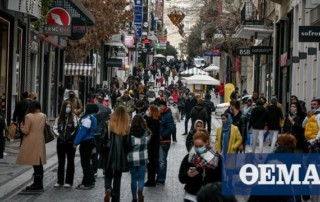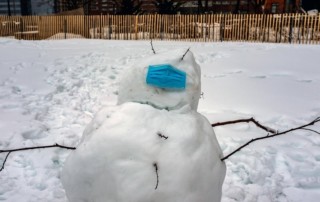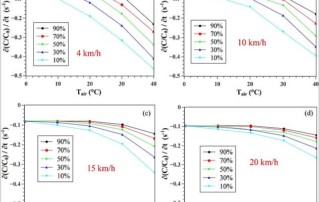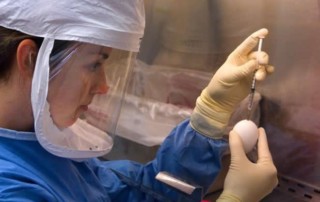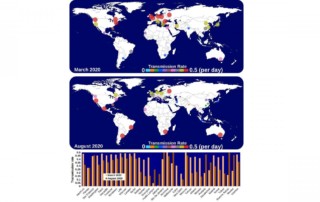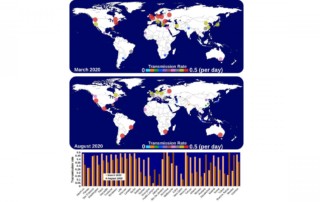COVID-19
UNIC Coronavirus Health and Research Portal
On Seasonality and Transmission Dynamics
Talib Dbouk and Dimitris Drikakis
University of Nicosia, Nicosia, Cyprus
Epidemic models do not account for the effects of climate conditions on the transmission dynamics of viruses. This study presents the vital relationship between weather seasonality, airborne virus transmission, and pandemic outbreaks over a whole year.
Using the data obtained from high-fidelity multi-phase, fluid dynamics simulations, we calculate the concentration rate of Coronavirus particles in contaminated saliva droplets and use it to derive a new Airborne Infection Rate (AIR) index.
Then, combining the simplest form of an epidemiological model, the susceptible–infected–recovered, and the AIR index, we show through data evidence how weather seasonality induces two outbreaks per year, as it is observed with the COVID-19 pandemic worldwide.
This study explains how pandemic outbreaks are associated with temperature, relative humidity, and wind speed changes independently of the particular season. For that reason, we propose that epidemiological models must incorporate climate effects to predict the pandemic curves behavior on a long-term basis.
Figure 1
An innovative scaling of the virus concentration rate (CR) with temperature (T), relative humidity (RH)) and wind speed (U). The solid square symbols represent the data points from the simulations. The lines (dashed, dotted-dashed, and solid) represent the single model predictions, which were found to fit all the data points very accurately. The two black solid lines are the maximum and minimum boundary limits for the range of data used to produce the results, (0 °C ≤ T ≤ 40 °C), (10% ≤ RH ≤ 90%), and (4 km/h ≤ U ≤ 20 km/h). The green and red circles show the strong and weak states of the virus particles, respectively. All the real variables are made dimensionless by the ⟨∗⟩ operator.
Figure 2
Weather-dependent airborne virus transmission rate in different cities worldwide during March and August 2020. The highest transmission, related to the Coronavirus airborne concentration rate, is found to be about 0.5 per day. The above implies that the probability is P = 1 (100%) for a susceptible individual to be infected in two days due to the weather conditions (wind speed, temperature, and relative humidity) in different regions.
Figure 3
Effect of weather conditions (wind speed, temperature, and relative humidity) on the Airborne Infection Rate index (AIR) for New York state (USA) in 2020. The hat symbol denotes daily weather data averaged per month. (a) Weather data recorded between March and October 2020 (included) and estimated weather data between November 2020 and February 2021 based on the last year’s recorded weather. (b) Weather dependent transmission rate shows three trends: high, medium, and low separated by the respective threshold values of 0.40 and 0.30. (c) Pandemic modeling and long-time prediction (daily number of cases) using the weather-dependent transmission rate (b) in the standard SIR model. Two outbreaks predicted due to the weather seasonality in New York using I = 1 as approximate total infected individual on 01 March 2020. Ntotal ≈ 19.47 million.
What Does This Mean?
There exists a direct relationship between weather seasonality and the pandemic evolution in different countries. This new relationship between weather seasonality and airborne virus transmission is quantified in the present study. It is then introduced into the SIR epidemiological model. The new model predicts pandemic outbreaks connected with main weather parameters: temperature, wind speed, and relative humidity. The significant findings are:
- Weather plays an important role in the pandemic outbreaks. Therefore, it must be included in epidemiological predictions.
- The Airborne Infection Rate (AIR) index defined in this study through the concentration rate (CR) provides a direct link between multiphase fluid dynamics and the disease’s spread.
- The results suggest that two pandemic outbreaks per year are more likely a natural phenomenon directly related to the weather seasonality during a pandemic evolution. The above puts in question large scale, strict lockdowns, but, indeed, the decisions for the above are associated with broader socio-economic issues.
- We can slow down the spread of the disease but cannot stop a second wave. The social protective measures, the extensive testing and contact tracing using electronic tracking devices, and foremost checking everybody at the entry into a country and quarantine rules in designated places, would help reduce the virus’s spread.
- The proposed AIR index can be used in conjunction with any SIR or SIR-derived model.
The University of Nicosia (UNIC)
About the University of Nicosia
The University of Nicosia (UNIC) is the largest university in Cyprus, and the largest university in southern Europe that teaches primarily in English, welcoming 12,000+ students from over 70 countries worldwide. The University of Nicosia is a comprehensive university with 6 schools, 20 departments and over 100 degree programs offered on-campus and online.
The University of Nicosia is best known in the fields of medicine, law, blockchain, accounting, education, forecasting and international relations and for a series of partnerships with other leading European universities. UNIC was most recently ranked #106 in its region by QS and #300 to #400 globally in the Times Higher Education Impact rankings.
To learn more about the University of Nicosia, please see: https://www.unic.ac.cy/
UNIC’s COVID-19 Response
University of Nicosia faculty across a variety of academic disciplines are actively engaged in research and analysis and serving in scientific / public policy roles supporting the global COVID-19 response.
For more information about the University of Nicosia’s work relating to COVID-19 including potential collaboration, please see: https://www.unic.ac.cy/coronavirus/
Contact Information
For more information about this study, please contact Prof Dimitris Drikakis at drikakis.d@unic.ac.cy.
For more information on our COVID-19 related research in general, please contact UNIC at covid19@unic.ac.cy.
Press Coverage
Articles and press mentions in global media about the research.
Τα καιρικά που επηρεάζουν την μεταδοτικότητα του κορωνοϊού
Μελέτη για το πώς επηρεάζεται η μεταδοτικότητα του ιού από τις κλιματολογικές συνθήκες, δημοσιεύτηκε από δύο καθηγητές του Πανεπιστημίου Λευκωσίας, τον Δημήτρη Δρικάκη και τον Talib Dbouk. Τα αποτελέσματα της συγκεκριμένης μελέτης έδειξαν ότι, η έλλειψη συμπερίληψης των κλιματολογικών παραγόντων στα επιδημιολογικά δεδομένα, μπορεί να αφήσει ένα κενό στο οποίο οι επιπτώσεις από την μετάδοση του ιού να είναι δραματικές.
Οι καιρικές συνθήκες πρέπει να λαμβάνονται υπόψη στην Πρόβλεψη ενός Δεύτερου Κύματος μιας Πανδημίας
Οι ερευνητές του Πανεπιστημίου Λευκωσίας Talib Dbouk και Δημήτρης Δρικάκης, στην πρόσφατη δημοσίευσή τους για τον COVID-19 στο Physics of Fluids, καταδεικνύουν πως η θερμοκρασία, η υγρασία και ο άνεμος είναι βασικοί επιδημιολογικοί παράμετροι που παραλείπονται από τις προβλέψεις
Κορωνοϊός: Τι ρόλο παίζει ο καιρός στην εξάπλωση της πανδημίας – Τι λέει νέα έρευνα
Κορωνοϊός: Τι ρόλο παίζει ο καιρός στην εξάπλωση της πανδημίας - Τι λέει νέα έρευνα «Η μάσκα και η κοινωνική απόσταση είναι αποτελεσματικές, αλλά δεν είναι αρκετές για την εξάλειψη του παθογόνου», αναφέρουν οι επιστήμονες από το Πανεπιστήμιο της Λευκωσίας Ανεξαρτήτως από το αν φοράμε μάσκα και κρατάμε τις κοινωνικές αποστάσεις, οι καιρικές συνθήκες, όπως η θερμοκρασία η υγρασία και ο άνεμος, διαδραματίζουν σημαντικό ρόλο στο πότε και και πού θα χτυπήσει ένα νέο κύμα πανδημίας του κορωνοϊού, σύμφωνα με κυπριακή έρευνα. [...]
KLIMA-EPIDEMIOLOGISCHES MODELL: CORONA IST EIN WINTERVIRUS
KLIMA-EPIDEMIOLOGISCHES MODELL: CORONA IST EIN WINTERVIRUS Das wollen nun zwei Physiker der Universität Nikosia auf Zypern ändern und präsentieren ein Modell, das die klimatischen Schwankungen auf der Erde miteinbezieht. Talib Dbouk und Dimitris Drikakis berichten im Fachmagazin Physics of Fluids von ihrer Arbeit, am Computer das Verhalten von Viruspartikeln in der Luft mit der Epidemiologie zusammenzubringen. Dafür nutzten sie neben dem epidemiologischen auch Modelle der Fluid-Dynamik. Read the full article here: KLIMA-EPIDEMIOLOGISCHES MODELL: CORONA IST EIN WINTERVIRUS
Temperature, humidity and wind could be used to predict another wave of coronavirus
Temperature, humidity and wind could be used to predict another wave of coronavirus Air temperature and humidity play a key role in determining when and where a second wave of the pandemic will strike, new research shows. Researchers say current forecasting models only take into account two factors – rate of transmission and recovery. But by including data on humidity and temperature, researchers from Cyprus have been able to add a level of nuance that allows for more accurate forecasting. [...]
Fale pandemii mogą być powodowane zmiennością pogodową. Każdego roku będą dwie fale?
Fale pandemii mogą być powodowane zmiennością pogodową. Każdego roku będą dwie fale? Autorzy badań, Talib Dbouk i Dimitris Drikakis z Uniwersytetu w Nikozji, wykorzystali symulacje dynamiki płynów do obliczenia koncentracji wirusa w zakażonej ślinie. Na tej podstawie stworzyli indeks AIR (Airborne Infection Rate). Skojarzyli go z prostym modelem epidemiologicznym i na tej podstawie stwierdzili, że to pogoda odpowiada za pojawienie się dwóch fal epidemii. Read the full article here: Fale pandemii mogą być powodowane zmiennością pogodową. Każdego roku będą dwie [...]
Könnte ein Lockdown mit Wetterdaten vermieden werden?
Könnte ein Lockdown mit Wetterdaten vermieden werden? Wenn man das Wetter beim Verlauf der Corona-Pandemie mehr berücksichtigen würde, könnte man eher Vorhersagen für eine neue Welle treffen und somit gezielter Massnahmen treffen, um harte Lockdowns zu vermeiden. Zu diesem Schluss kommen zypriotische Forscher. Deshalb sollten Wetterdaten stärker in Modelle zur Ausbreitung des Virus einbezogen werden, schreiben Dimitris Drikakis und Talib Dbouk von der Universität Nikosia im Fachmagazin «Physics of Fluids». Denn die Übertragungsraten hängen von der Wetterbedingungen ab. Read the [...]
Airborne Infection Rate index predicts timing of second wave of pandemic
Airborne Infection Rate index predicts timing of second wave of pandemic The "second wave" of the coronavirus pandemic has placed much blame on a lack of appropriate safety measures. However, due to the impacts of weather, research suggests two outbreaks per year during a pandemic are inevitable. Read the full article here: Airborne Infection Rate index predicts timing of second wave of pandemic Source: Airborne Infection Rate index predicts timing of second wave of pandemic
Temperature, humidity, wind predict second wave of pandemic
Temperature, humidity, wind predict second wave of pandemic The 'second wave' of the coronavirus pandemic has resulted in much blame placed on a lack of appropriate safety measures. However, due to the impacts of weather, research suggests two outbreaks per year during a pandemic are inevitable. Read the full article here: Temperature, humidity, wind predict second wave of pandemic
Temperature, humidity, wind predict second wave of pandemic
Temperature, humidity, wind predict second wave of pandemic Though face masks, travel restrictions, and social distancing guidelines help slow the number of new infections in the short term, the lack of climate effects incorporated into epidemiological models presents a glaring hole that can cause long-term effects. In Physics of Fluids, from AIP Publishing, Talib Dbouk and Dimitris Drikakis, from the University of Nicosia in Cyprus, discuss the impacts of these parameters. Read the full article here: Temperature, humidity, wind predict [...]

